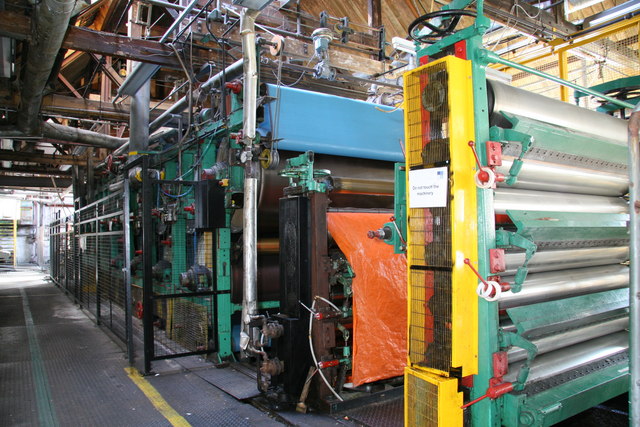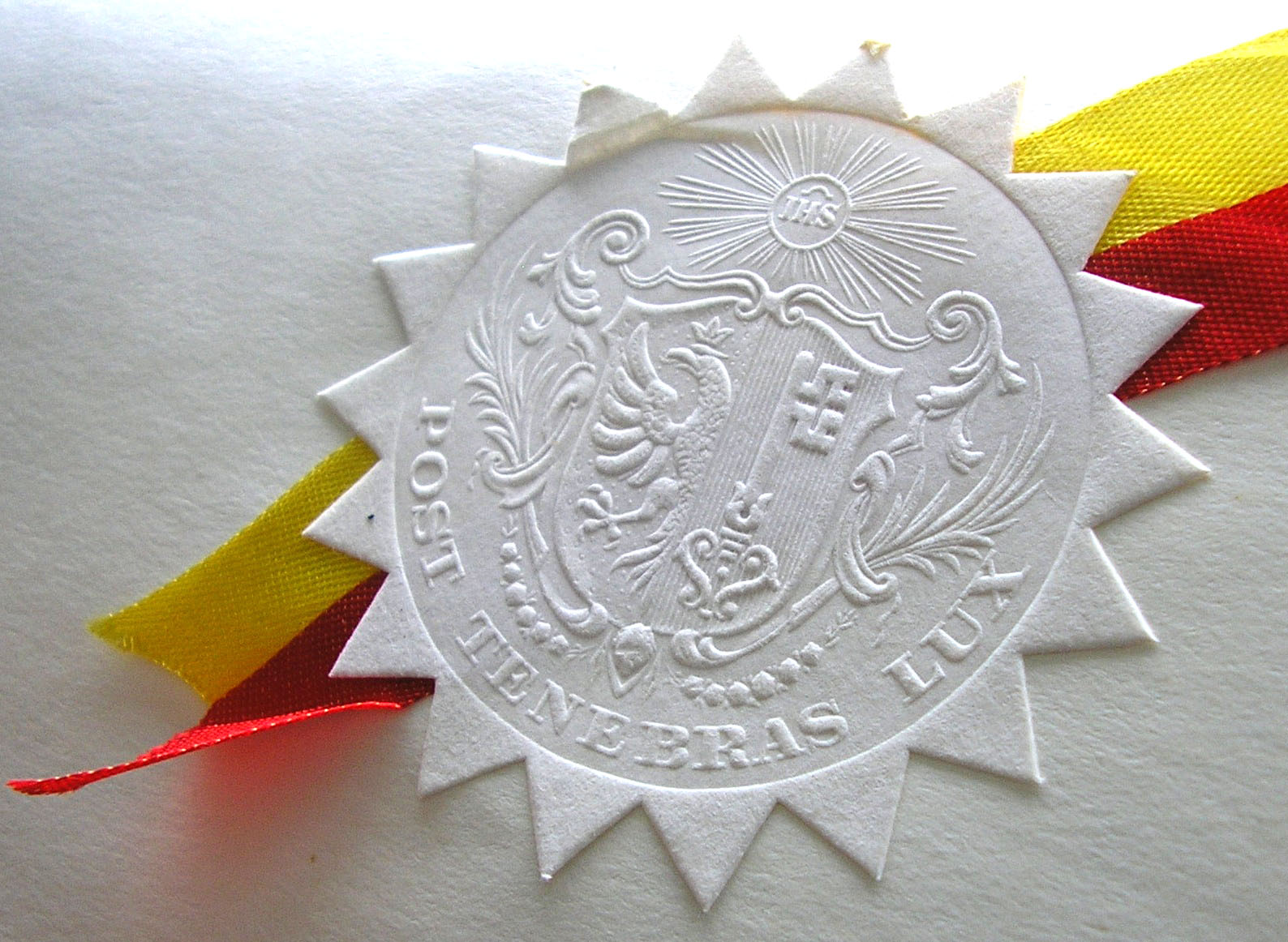|
Büttenpapierfabrik Gmund
The Büttenpapierfabrik Gmund GmbH & Co. KG is a paper manufacturer with its headquarters in Gmund am Tegernsee and about 120 employees. The company operates in papermaking in the sectors fine paper, woodfree uncoated paper and paper products. Gmund customers in about 70 countries. History From the beginnings, under the management of Johann Nepomuk Haas, founder of the company, GMUND started to produce fine hand made papers. The Kohler family, who has been running the company since 1904, continued this idea and also developed it further on to suit the times. Johann Nepomuk Haas founded the paper mill in 1829. He had the license to collect rags, which you needed to produce paper. Till 1850 paper was exclusively made from rags. In 1854 Gregor Fichtner took over responsibility for the business and extended it to 60 employees. He concentrated on producing hand made fine paper and supplying papers for official and government documentation. At that time Gmund was purveyor to the Bava ... [...More Info...] [...Related Items...] OR: [Wikipedia] [Google] [Baidu] |
Germany
Germany,, officially the Federal Republic of Germany, is a country in Central Europe. It is the second most populous country in Europe after Russia, and the most populous member state of the European Union. Germany is situated between the Baltic and North seas to the north, and the Alps to the south; it covers an area of , with a population of almost 84 million within its 16 constituent states. Germany borders Denmark to the north, Poland and the Czech Republic to the east, Austria and Switzerland to the south, and France, Luxembourg, Belgium, and the Netherlands to the west. The nation's capital and most populous city is Berlin and its financial centre is Frankfurt; the largest urban area is the Ruhr. Various Germanic tribes have inhabited the northern parts of modern Germany since classical antiquity. A region named Germania was documented before AD 100. In 962, the Kingdom of Germany formed the bulk of the Holy Roman Empire. During the 16th ce ... [...More Info...] [...Related Items...] OR: [Wikipedia] [Google] [Baidu] |
Woodfree Uncoated Paper
Woodfree uncoated paper (WFU), uncoated woodfree paper (UWF) or uncoated fine papers are manufactured using wood that has been processed into a chemical pulp that removes the lignin from the wood fibers and may also contain 5–25% fillers. Both softwood and hardwood chemical pulps are used and a minor part of mechanical pulp might be added (often of aspen or poplar). These paper grades are calendered. Properties Woodfree uncoated papers are of high quality and have a natural look and feel. The properties are good strength, high brightness and good archival characteristics. They provide a non-glare surface suitable for reading and writing. Special types ''Offset paper'' is a WFU paper with ISO brightness > 80% and a basis weight of 40–300 g/m2. Surface strength and low linting are the main parameters, but brightness and opacity are also important. ''Lightweight offset paper'', also called onionskin, has a basis weight of 25–40 g/m2 and are normally used for bibles (hence th ... [...More Info...] [...Related Items...] OR: [Wikipedia] [Google] [Baidu] |
Paper
Paper is a thin sheet material produced by mechanically or chemically processing cellulose fibres derived from wood, rags, grasses or other vegetable sources in water, draining the water through fine mesh leaving the fibre evenly distributed on the surface, followed by pressing and drying. Although paper was originally made in single sheets by hand, almost all is now made on large machines—some making reels 10 metres wide, running at 2,000 metres per minute and up to 600,000 tonnes a year. It is a versatile material with many uses, including printing, painting, graphics, signage, design, packaging, decorating, writing, and cleaning. It may also be used as filter paper, wallpaper, book endpaper, conservation paper, laminated worktops, toilet tissue, or currency and security paper, or in a number of industrial and construction processes. The papermaking process developed in east Asia, probably China, at least as early as 105 CE, by the Han court eunuch Cai Lun, although the ... [...More Info...] [...Related Items...] OR: [Wikipedia] [Google] [Baidu] |
Gmund Am Tegernsee
Gmund am Tegernsee is a municipality in the district of Miesbach in Bavaria in Germany. The town is located on the north shore of the Tegernsee Lake, and near the source of River Mangfall. It is from Munich and from the district capital, the town of Miesbach. Famous personalities who lived in Gmund were the Federal Chancellor of the Federal Republic of Germany Ludwig Erhard, who is buried in Gmund's cemetery, the architect Sep Ruf and the clockmaker Johann Mannhardt. Reichsführer Heinrich Himmler and his family maintained a home there from 1934 to 1945. Gmund is served by a station on the privately owned Tegernsee-Bahn railway, and is linked to Munich by through trains of the Bayerische Oberlandbahn The Bayerische Oberlandbahn GmbH (BOB) is a private railway company based in Holzkirchen, Germany, and owned by Transdev Germany (formerly known as ''Veolia Verkehr''). Since June 2020 its services are operated under the brand Bayerische Regiob .... Image:Gmund Rathaus.j ... [...More Info...] [...Related Items...] OR: [Wikipedia] [Google] [Baidu] |
Fine Paper
Fine papers are printing and writing paper grades based mainly on chemical pulps. Normally the content of mechanical pulps are below 10% and the amount of fillers in the range 5–25%. Production Fine papers are normally surface sized or pigmented with calcium carbonate. Uncoated fine papers are calendered in the paper machine. Types *Bible paper *Coated fine paper *Inkjet paper *Thermal paper *Woodfree uncoated paper Woodfree uncoated paper (WFU), uncoated woodfree paper (UWF) or uncoated fine papers are manufactured using wood that has been processed into a chemical pulp that removes the lignin from the wood fibers and may also contain 5–25% fillers. Both s ... References Paper {{publish-stub ... [...More Info...] [...Related Items...] OR: [Wikipedia] [Google] [Baidu] |
Textile
Textile is an umbrella term that includes various fiber-based materials, including fibers, yarns, filaments, threads, different fabric types, etc. At first, the word "textiles" only referred to woven fabrics. However, weaving is not the only manufacturing method, and many other methods were later developed to form textile structures based on their intended use. Knitting and non-woven are other popular types of fabric manufacturing. In the contemporary world, textiles satisfy the material needs for versatile applications, from simple daily clothing to bulletproof jackets, spacesuits, and doctor's gowns. Textiles are divided into two groups: Domestic purposes onsumer textilesand technical textiles. In consumer textiles, aesthetics and comfort are the most important factors, but in technical textiles, functional properties are the priority. Geotextiles, industrial textiles, medical textiles, and many other areas are examples of technical textiles, whereas clothing and ... [...More Info...] [...Related Items...] OR: [Wikipedia] [Google] [Baidu] |
Munich
Munich ( ; german: München ; bar, Minga ) is the capital and most populous city of the States of Germany, German state of Bavaria. With a population of 1,558,395 inhabitants as of 31 July 2020, it is the List of cities in Germany by population, third-largest city in Germany, after Berlin and Hamburg, and thus the largest which does not constitute its own state, as well as the List of cities in the European Union by population within city limits, 11th-largest city in the European Union. The Munich Metropolitan Region, city's metropolitan region is home to 6 million people. Straddling the banks of the River Isar (a tributary of the Danube) north of the Northern Limestone Alps, Bavarian Alps, Munich is the seat of the Bavarian Regierungsbezirk, administrative region of Upper Bavaria, while being the population density, most densely populated municipality in Germany (4,500 people per km2). Munich is the second-largest city in the Bavarian dialects, Bavarian dialect area, ... [...More Info...] [...Related Items...] OR: [Wikipedia] [Google] [Baidu] |
Paper Machine
A paper machine (or paper-making machine) is an industrial machine which is used in the pulp and paper industry to create paper in large quantities at high speed. Modern paper-making machines are based on the principles of the Fourdrinier Machine, which uses a moving woven mesh to create a continuous paper web by filtering out the fibres held in a paper stock and producing a continuously moving wet mat of fibre. This is dried in the machine to produce a strong paper web. The basic process is an industrialised version of the historical process of hand paper-making, which could not satisfy the demands of developing modern society for large quantities of a printing and writing substrate. The first modern paper machine was invented by Louis-Nicolas Robert in France in 1799, and an improved version patented in Britain by Henry and Sealy Fourdrinier in 1806. The same process is used to produce paperboard on a paperboard machine. Process sections Paper machines usually have at leas ... [...More Info...] [...Related Items...] OR: [Wikipedia] [Google] [Baidu] |
Europe
Europe is a large peninsula conventionally considered a continent in its own right because of its great physical size and the weight of its history and traditions. Europe is also considered a Continent#Subcontinents, subcontinent of Eurasia and it is located entirely in the Northern Hemisphere and mostly in the Eastern Hemisphere. Comprising the westernmost peninsulas of Eurasia, it shares the continental landmass of Afro-Eurasia with both Africa and Asia. It is bordered by the Arctic Ocean to the north, the Atlantic Ocean to the west, the Mediterranean Sea to the south and Asia to the east. Europe is commonly considered to be Boundaries between the continents of Earth#Asia and Europe, separated from Asia by the drainage divide, watershed of the Ural Mountains, the Ural (river), Ural River, the Caspian Sea, the Greater Caucasus, the Black Sea and the waterways of the Turkish Straits. "Europe" (pp. 68–69); "Asia" (pp. 90–91): "A commonly accepted division between Asia and E ... [...More Info...] [...Related Items...] OR: [Wikipedia] [Google] [Baidu] |
Paper Embossing
Embossing and debossing are the processes of creating either raised or recessed relief images and designs in paper and other materials. An embossed pattern is raised against the background, while a debossed pattern is sunken into the surface of the material but might protrude somewhat on the reverse side. Techniques Often used in combination with foil stamping, embossing alters the surface of paper stock or other substrates by providing a three-dimensional or raised effect on selected areas. The procedure requires the use of two dies: one that is raised and one that is recessed. The dies fit into each other so that when the paper is pressed between them, the raised die forces the stock into the recessed die and creates the embossed impression. A specific level of pressure is applied to the dies in order to squeeze the fibers of the paper, which results in a permanently raised area in the paper. When the dies are produced, a die maker engraves the desired image into several me ... [...More Info...] [...Related Items...] OR: [Wikipedia] [Google] [Baidu] |
World War II
World War II or the Second World War, often abbreviated as WWII or WW2, was a world war that lasted from 1939 to 1945. It involved the vast majority of the world's countries—including all of the great powers—forming two opposing military alliances: the Allies and the Axis powers. World War II was a total war that directly involved more than 100 million personnel from more than 30 countries. The major participants in the war threw their entire economic, industrial, and scientific capabilities behind the war effort, blurring the distinction between civilian and military resources. Aircraft played a major role in the conflict, enabling the strategic bombing of population centres and deploying the only two nuclear weapons ever used in war. World War II was by far the deadliest conflict in human history; it resulted in 70 to 85 million fatalities, mostly among civilians. Tens of millions died due to genocides (including the Holocaust), starvation, ma ... [...More Info...] [...Related Items...] OR: [Wikipedia] [Google] [Baidu] |




